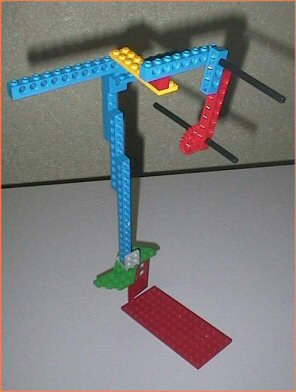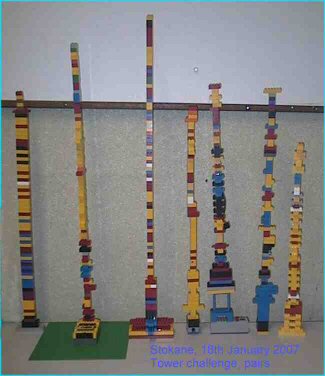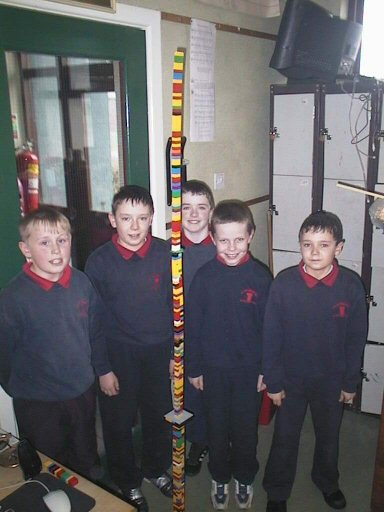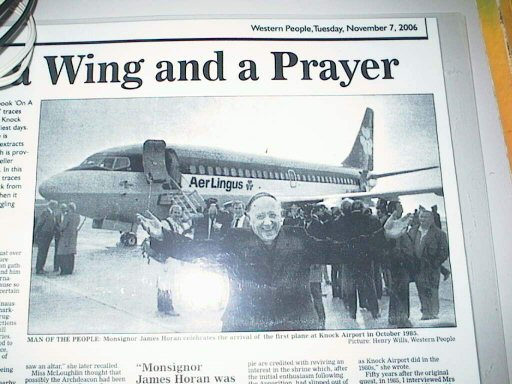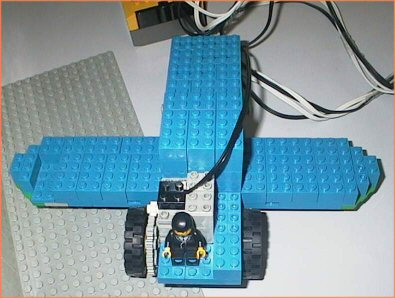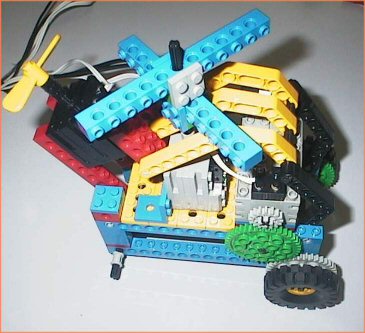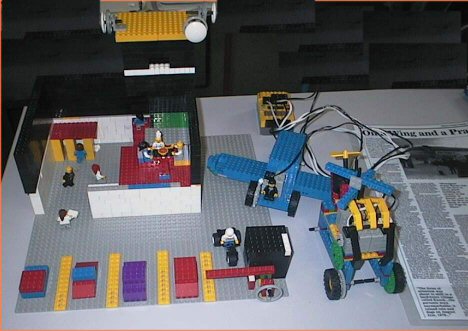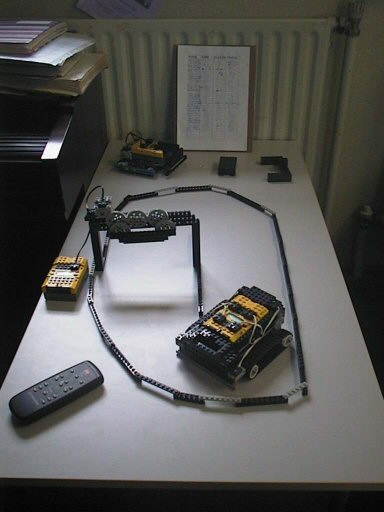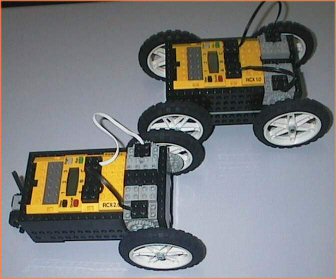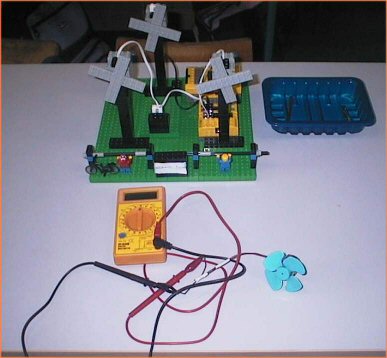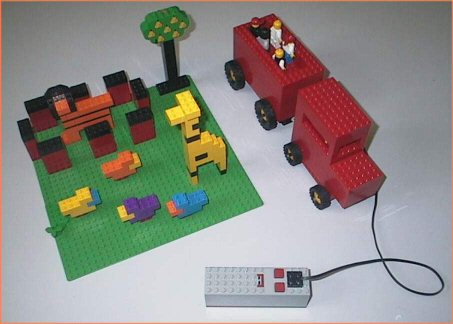Mindstorms and the RDS 2007
There is a great buzz of excitement in the school as preparations are made for the annual trip to the Young Scientist Exhibition at the RDS, Dublin in January each year. The project is supported by the NCTE and is the brainchild of Dr. Deirdre Butler, lecturer in St. Patrick's College of Education, Drumcondra, Dublin. Pupils from 3rd to 6th travel with a number of parents to display their projects on control technology. Models are built mainly using Lego, and controlled using the Lego RCX, and each project has a story which is told to visitors to the stand.
Here we show some of the items from the work we do in school and the games we play. We take some of these to display at the RDS. Click images to enlarge.
Lego Bingo
To play Lego Bingo, we need two trays with identical pieces of Lego in each. For example, if there is a red 2x2 brick in one of the trays there must be one in the other tray. The Bingomaster takes one tray to the top of the room and the other tray is passed around among the Bingo players. Each player takes four pieces of Lego from the tray. Each player has a card with four place holders on it. Bingomaster takes out a piece of Lego and shows it to the players, and then places it on the table. If the player has that piece he or she places it on one of the place holders. Bingomaster continues to take out pieces, one at a time. First to place all four pieces shouts Bingo. The player beside him or her calls out the pieces on the place holder, e.g. Red 2X2 brick, and Bingomaster says Check if it is present. All players return their pieces to their bin and Bingomaster returns the pieces on his or her table to the bin. A new game can take place, or both bins can be stored away for future use. Players should keep their pieces hidden from Bingomaster lest collusion should take place, especially if down to one piece, when a player would reveal what piece he or she needs to win the game. We sometimes play this game if it is too wet to go out to play or if we have ten minutes left before a break.
Tower of Babel
We read the story about the Tower of Babel in Genesis 11 and designed this game for two players. A player places a piece of Lego on the table and opponent attaches a piece to it, on top if possible. If an axle is used, next player can hang a beam or a gear on the axle. The object of the game is to leave a structure so precarious that when the opponent adds a piece, the structure topples just like the Tower of Babel. Best of three wins.
Tall Tower
Teams of two compete to build the tallest tower possible in three minutes. Tower heights are measured and the results graphed. Some players work individually and add one tower to the other as the countdown to zero begins. All hands must be taken off the towers when the time is up and only the towers which are still standing ten seconds later are eligible for the competition.
Tallest tower at 1.94 metres
built by:
Keith, Jason, Jason, Martin and David, January 2007
Build a Replica
You need two people to play this game. Each takes five pieces of Lego and builds a structure. Each gives another set of the same materials to the other person, each shows them the model they just built, for 20 seconds, and then invites them to build a replica. First to finish wins. A match is best of three. The game can also be played with groups, or the whole class, if there are enough pieces to go round. One pupil builds a model and the others copy. A stopwatch is used and data collected as competitors finish. Senior pupils will find that using references is a help – for example, the model's base is always at 12 o'clock, next piece may be at 3, next at 12 next at 9 and so on. When the model is placed with its base against the chest, it's easy to see relationship to a clock.
Build a Mirror-image
This game is played the same as above, except that a mirror-image (when placed together, both models make a symmetrical pair) must be created. Pupils may find the time of 20 seconds too short. They will also discover that if the model can lie flat on the table (all pieces in the same plane; no "wings" protruding) that the task can too easily be completed.
Funeral of Michael Davitt
by Katie, Caitríona and Shannon
When Michael Davitt died in 1906, his body was taken to Foxford Railway Station by train and taken from there to Straide where he is buried. The model shows the train arriving into the station and the coffin being placed in the carriage. Thousands of people from all over Ireland turned up for the funeral. The pupils decided to use a battery box to power the train. The model is based on the story of the importance of Michael Davitt to the people of Mayo and Ireland. Michael set up the Land League in Mayo in April 1879. Our Lady appeared to 15 people in Knock later on in August of the same year, 1879. That was a very good year for Ireland. Soon afterwards, the government made loans available to those who rented land from the landlords, to enable them buy the land from the landlords. These loans were paid back over several years. Nowadays we may own our homes, and we may own farms, which we are free to sell if we wish. Michael Davitt was a great man. Visit Straide Museum near Foxford for the full story of his life. We visited it in 2006 on the school tour.
Mons. James Horan, the main driver behind the building of Knock Airport
Aisling, Ciara and Maria chose Knock Airport as their theme. They built the control tower, a helicopter and an aeroplane. Their project involved researching the history of flight and looking at the destinations planes travel to from Knock Airport.
Aeroplane at Knock Airport
Helicopter at Knock Airport
Knock Airport
Obstacle course
This course was designed by Keith and Kevin. The bulldozer is steered using the remote control, and the challenge is to steer the machine around the course in the fastest time possible. A three second time penalty applies if the boundary is struck. A table of results is obtained and graphed.
Drunk driver
These models show the law-abiding driver and the drink-driver. Both are programmed to move differently, with the drink-driver hogging the road and not really in control of the vehicle because his senses are dulled and not able to respond quickly enough to the contours of the road and the speed of the vehicle.
Try this tongue twister:
Drugs, when you're sick, make you well. Drugs make you sick when you're well.
(Note that the word "well" is at the end each time.)
Windfarm on King's Mountain
David and Keith built this windfarm. It is based on the farm on the western slopes of the Ox Mountains beside Stokane National School. They used a multimeter (Euro 5 in Mary's, Donegal Town) and a motor with impeller from Peats (Parnell St., Dublin) to test lung capacity. People with large healthy lungs will have a high lung capacity. Smoking damages lungs and lowers the lung capacity. David and Keith invited visitors to their stand at the RDS to blow onto the blades of the impeller to test their lung capacity. They recorded the results and made a graph.
Jungle Safari by Marianne and Sinéad
Marianne and Sinéad chose the Jungle Safari theme as their third class project. They are very good builders. They've been working with Lego Creator for a few years and this is their first year using gears, motors and battery boxes.

